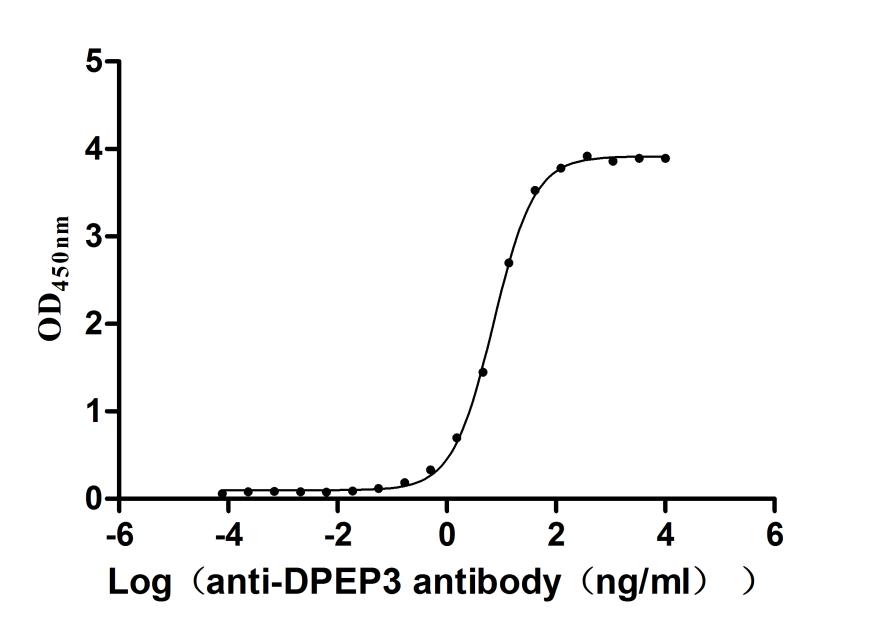Recombinant Rat Protein pelota homolog (Pelo)
-
中文名稱:大鼠Pelo重組蛋白
-
貨號:CSB-EP726377RA-B
-
說明書:
-
規格:
-
來源:E.coli
-
共軛:Avi-tag Biotinylated
E. coli biotin ligase (BirA) is highly specific in covalently attaching biotin to the 15 amino acid AviTag peptide. This recombinant protein was biotinylated in vivo by AviTag-BirA technology, which method is BriA catalyzes amide linkage between the biotin and the specific lysine of the AviTag.
-
其他:
產品詳情
-
純度:>85% (SDS-PAGE)
-
基因名:
-
Uniprot No.:
-
別名:Pelo; Protein pelota homolog; EC 3.1.-.-
-
種屬:Rattus norvegicus (Rat)
-
蛋白長度:full length protein
-
表達區域:1-385
-
氨基酸序列MKLVRKDIEK DNAGQVTLVP EEPEDMWHTY NLVQVGDSLR ASTIRKVQTE SSTGSVGSNR VRTTLTLCVE AIDFDSQACQ LRVKGTNIQE NEYVKMGAYH TIELEPNRQF TLAKKQWDSV VLERIEQACD PAWSADVAAV VMQEGLAHVC LVTPSMTLTR AKVEVNIPRK RKGNCSQHDR ALERFYEQVV QAIQRHINFE VVKCILVASP GFVREQFCDY MFQQAVKTDN KVLLENRSKF LQVHASSGHK YSLKEVLCDP TVASRLSDTK AAGEVKALDD FYKMLQHEPD RAFYGLKQVE RANEALAIDT LLISDELFRH QDVATRSRYV RLVDSVKENA GTVRIFSSLH VSGEQLGQLT GVAAILRFPV PELSDQEDDS SSEED
-
蛋白標簽:Tag?type?will?be?determined?during?the?manufacturing?process.
The tag type will be determined during production process. If you have specified tag type, please tell us and we will develop the specified tag preferentially. -
產品提供形式:Lyophilized powder
Note: We will preferentially ship the format that we have in stock, however, if you have any special requirement for the format, please remark your requirement when placing the order, we will prepare according to your demand. -
復溶:We recommend that this vial be briefly centrifuged prior to opening to bring the contents to the bottom. Please reconstitute protein in deionized sterile water to a concentration of 0.1-1.0 mg/mL.We recommend to add 5-50% of glycerol (final concentration) and aliquot for long-term storage at -20℃/-80℃. Our default final concentration of glycerol is 50%. Customers could use it as reference.
-
儲存條件:Store at -20°C/-80°C upon receipt, aliquoting is necessary for mutiple use. Avoid repeated freeze-thaw cycles.
-
保質期:The shelf life is related to many factors, storage state, buffer ingredients, storage temperature and the stability of the protein itself.
Generally, the shelf life of liquid form is 6 months at -20°C/-80°C. The shelf life of lyophilized form is 12 months at -20°C/-80°C. -
貨期:Delivery time may differ from different purchasing way or location, please kindly consult your local distributors for specific delivery time.Note: All of our proteins are default shipped with normal blue ice packs, if you request to ship with dry ice, please communicate with us in advance and extra fees will be charged.
-
注意事項:Repeated freezing and thawing is not recommended. Store working aliquots at 4°C for up to one week.
-
Datasheet :Please contact us to get it.
靶點詳情
-
功能:Cotranslational quality control factor involved in the No-Go Decay (NGD) pathway. In the presence of ABCE1 and HBS1L, is required for 48S complex formation from 80S ribosomes and dissociation of vacant 80S ribosomes. Together with HBS1L and in presence of ABCE1, recognizes stalled ribosomes and promotes dissociation of elongation complexes assembled on non-stop mRNAs; this triggers endonucleolytic cleavage of the mRNA, a mechanism to release non-functional ribosomes and to degrade damaged mRNAs as part of the No-Go Decay (NGD) pathway. As part of the PINK1-regulated signaling, upon mitochondrial damage is recruited to the ribosome/mRNA-ribonucleoprotein complex associated to mitochondrial outer membrane thereby enabling the recruitment of autophagy receptors and induction of mitophagy.
-
亞細胞定位:Nucleus. Cytoplasm.
-
蛋白家族:Eukaryotic release factor 1 family, Pelota subfamily
-
數據庫鏈接:
Most popular with customers
-
Recombinant Human Pro-neuregulin-1, membrane-bound isoform (NRG1), partial (Active)
Express system: Mammalian cell
Species: Homo sapiens (Human)
-
Recombinant Human Tyrosine-protein kinase Mer (MERTK), partial (Active)
Express system: Mammalian cell
Species: Homo sapiens (Human)
-
Recombinant Human T-cell surface protein tactile (CD96), partial (Active)
Express system: Mammalian cell
Species: Homo sapiens (Human)
-
Recombinant Human Dipeptidase 3(DPEP3), partial (Active)
Express system: Mammalian cell
Species: Homo sapiens (Human)


-AC1.jpg)

-AC1.jpg)











